Categories: How does it work
Number of views: 17251
Comments on the article: 0
The device of a flowing water heater, principle of operation, scheme, varieties
Hot water supply of a house or apartment can be centralized, or it can be individual. Even if you have a centralized hot water supply system, you should take care of a backup solution in case of its termination. There are several ways to solve this issue:
1. Installation of a gas water heater. Requires coordination with the gas supply organization, hoods.
2. Installing a storage water heater. Great solution, low power consumption. They usually have TENs of 1-3 kW, which will allow them to be connected in an apartment with a standard amount of allocated power (about 3.5 kW in Khrushchev).
But there is a huge drawback - the storage water heater itself is not heavy (20-30 kg), but depending on the model, it can accumulate from several tens to several hundred liters of water. This can cause problems in the installation of such a heater, for example, in an old brick or wooden house you will have to make stands, rather than fasten it to the wall.
3. Installation of instantaneous water heater. Its weight and dimensions are small, which allows it to be installed in a cabinet or under the sink.
Let's look at the design of the instantaneous water heater, its advantages and disadvantages.
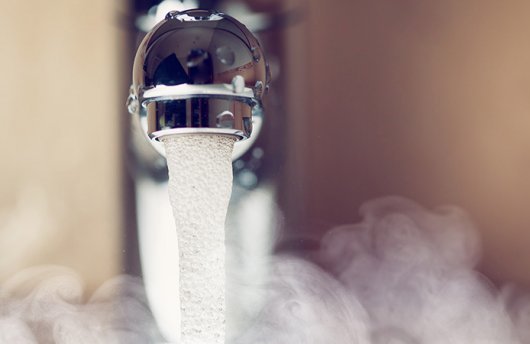
Design
Instantaneous water heater consists of:
-
Housings.
-
Heat exchanger.
-
TENOV.
-
Control systems. Consists of a temperature controller and a flow sensor. Depending on the model, it can be supplemented by an indication, for example, displaying the temperature on the display.
-
Pipes connecting to the pipeline.
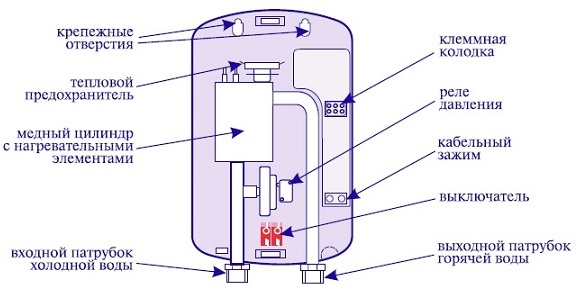
I call a heat exchanger a unit in which water is heated, usually a heater is installed in it. In order for the flowing water to have time to heat up, the heat exchanger should be as small as possible in volume, and the heater should be as powerful as possible. In miniature models, spiral heaters are used, in large ones several direct heating elements are installed.
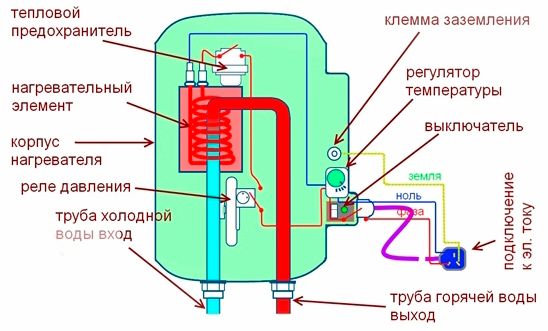
When you open the water, the flow sensor is triggered, it controls the coil of the relay, which supplies power to the heater. When you turn off the water, the contacts of the flow sensor open and the heating elements will turn off. If this does not happen, one of the temperature sensors will work.
Usually there are two of them - one sets the temperature of the water, the other responds to critical heating. The second sensor has a manual switch, if it works, you will have to remove the front panel of the instantaneous water heater and turn it on. There may be other sensors depending on the model.
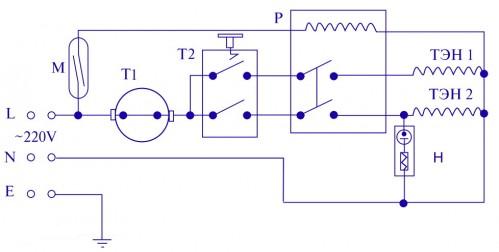
This is a typical electric circuit of a flowing water heater, where M is a flow sensor, T1 is a thermostat, T2 is an emergency thermostat with manual on, P is a relay.
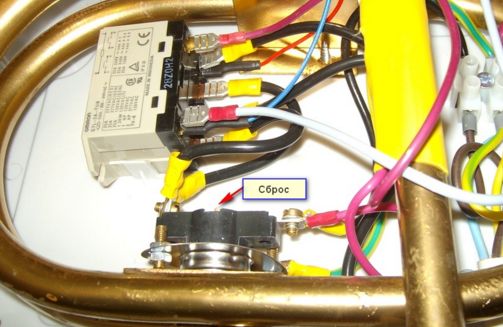
In the photo you see the thermostat power button.
Simplified design possible - no relays. Here, a pressure sensor and a temperature sensor will protect the heating elements from idle operation.
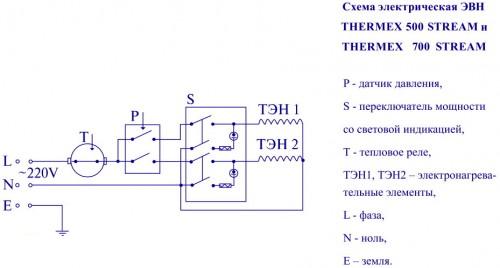
The control scheme is needed to turn on the heating elements when you opened the water, and turn them off when you closed the water or it ended.
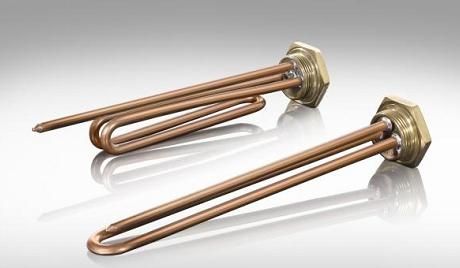
If such a heating element works without water flow, damage to pipelines is possible, due to boiling water, if it works in a dry environment, it will burn.
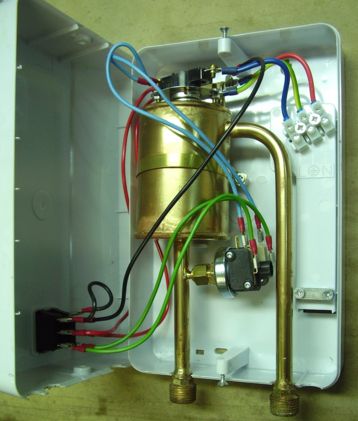
Accumulative water heaters store water in themselves, they consist of an accumulative tank and TENA, the principle of action consists in gradual heating of water. In flowing - instant heating is needed.
From here comes the main disadvantage of instantaneous water heaters, in order to provide you with hot water with a good pressure, its power should be more than 5 kW. Not every house or apartment has the ability to connect such loads. Maximum power is often limited. automatic 16-32A in the electrical panel. And to increase it, you need to contact the supplying organization with an electrical project and a package of documents.
This design provides one point with hot water. That is, if you want hot water to flow simultaneously in the kitchen and in the bathroom - you will have to install two water heaters.
Typical Malfunctions
Most often in heating appliances TEN fails. In flow heaters it lasts longer than in storage heaters; scale on its surface appears very slowly.
From overheating, as already mentioned, it is protected by two temperature sensors. If the heater does not cool, it will burn.
One of the sensors is set to a temperature of about 60 ° C, when this temperature is reached, the heating circuit of the heating element opens, when the temperature drops, it closes. An increase in temperature can be due to poor water pressure, clogged pipes and other things. The second sensor is emergency, it will work when it reaches 90 ° C.
After the heater cools down, you need to remove its front panel and manually put the sensor in the normal position in which its contacts are closed. To do this, there is a button on the sensor housing.
A pressure switch and a flow sensor are needed to protect the heating elements at low water pressure and when you close the tap.
All sensors fail over time, they just need to be replaced, their repair in most cases is either impossible or impractical.
If the heating elements are switched on via a relay, the following problems are possible:
1. Open or interturn circuit of the relay coil.
2. Burning the contact group.
There are simpler malfunctions: burning wires, the destruction of terminal blocks, and more. This is due to the fact that they are in conditions with high temperature, the insulation of the wires can be broken, the plastic housing of the terminal blocks becomes fragile - this leads to problems. In this case, you just need to repair the damaged connections and wires.
Connection to the pipeline
The instantaneous water heater is installed in close proximity to the hot water consumption points:
-
sinks;
-
washbasins;
-
kitchens;
-
bathtubs.
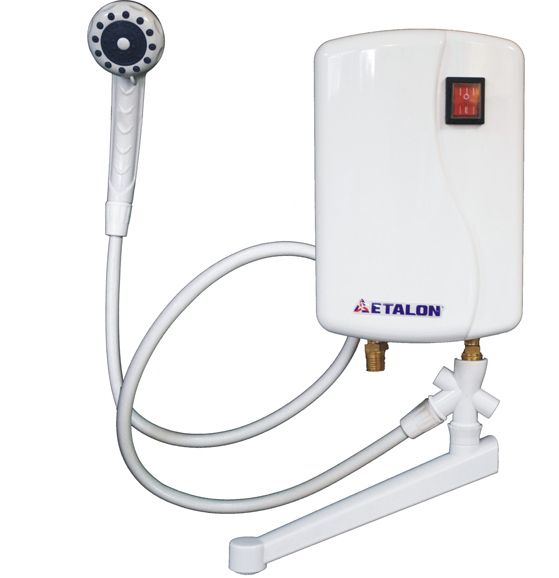
At the same time, depending on the version, they can be used in a bathtub or washbasin, with shower or combined.

Powerful heaters can be used to supply water to several points, then the connection scheme to the pipeline is as follows:
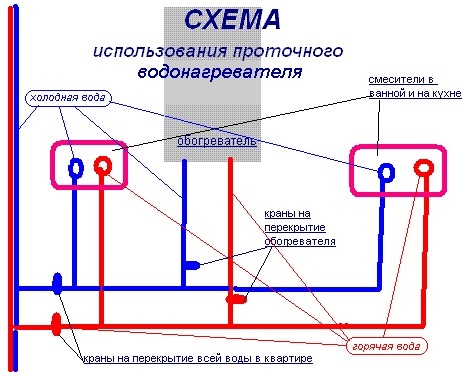
Similar to a gas boiler or boiler, however, in order to provide hot water at two points, you will need at least 10-15 kW of power. Therefore, in most cases, with such a connection, hot water can only be used at one point at a time.
Water faucet
A particular case of the design of a flowing water heater is a tap with the function of heating the water. The power of such devices is usually 1-3 kW.
This instantaneous water heater no longer represents a separate unit, in it the heater is located in the tap body, it resembles a conventional mixer, it can operate both in the mode of a conventional cold water tap and as a hot water tap. This allows you to organize a hot water system without wiring an additional "hot" pipe.

The heater in such a heater is located in the base, a regular gander is removed from it. Water temperature is regulated by changing the flow of water. On more expensive models there is a display with a temperature indication.
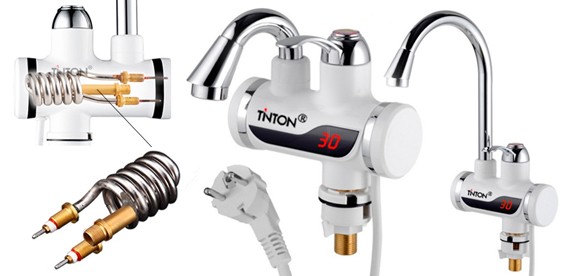
Such grooves are able to heat water, but with a strong pressure it will heat up by 5-10 degrees. This is especially critical when warming ice water from a well. To achieve high temperature, you will have to turn off the tap, but then there will be a low pressure. A specific device, while it’s better to connect it through RCD or difavtomat, and the socket must be grounded so as not to get a pressure of water under voltage.
Conclusion
To summarize. Advantages of instantaneous water heaters:
-
There is no need for gas, therefore, you do not need to connect to the pipe and draw up documents in a gas supplying organization.
-
Light weight and dimensions allow you to hide in the nightstand under the sink, in the cabinet or just hang on any wall.
-
Low cost. Their price is 2 or more times lower than that of boilers.
Disadvantages:
-
Great power. Most instantaneous heaters have a capacity of more than three kilowatts. It is necessary to lay a separate cable, power it through a separate machine and RCD.
-
The consequence of high power is high energy consumption. This drawback negates the low cost, you will overpay later when the electricity bills come.
-
The inability to connect in most apartments and cottages, again, because of the power.
-
It is highly recommended not to use without grounding.
-
Most likely, it will not be possible to get hot water from several taps at the same time.
For comparison, the thermal power of gas flow heaters (columns) of 15 and more kilowatts, it is easy to draw conclusions about the effectiveness of electric and gas water heaters. The capacity of the storage water heater (boiler) is usually about 2 kilowatts and it can be used in almost any apartment, in addition, the heated water retains its heat for a long time due to its heat-insulating properties.
See also at i.electricianexp.com
:
